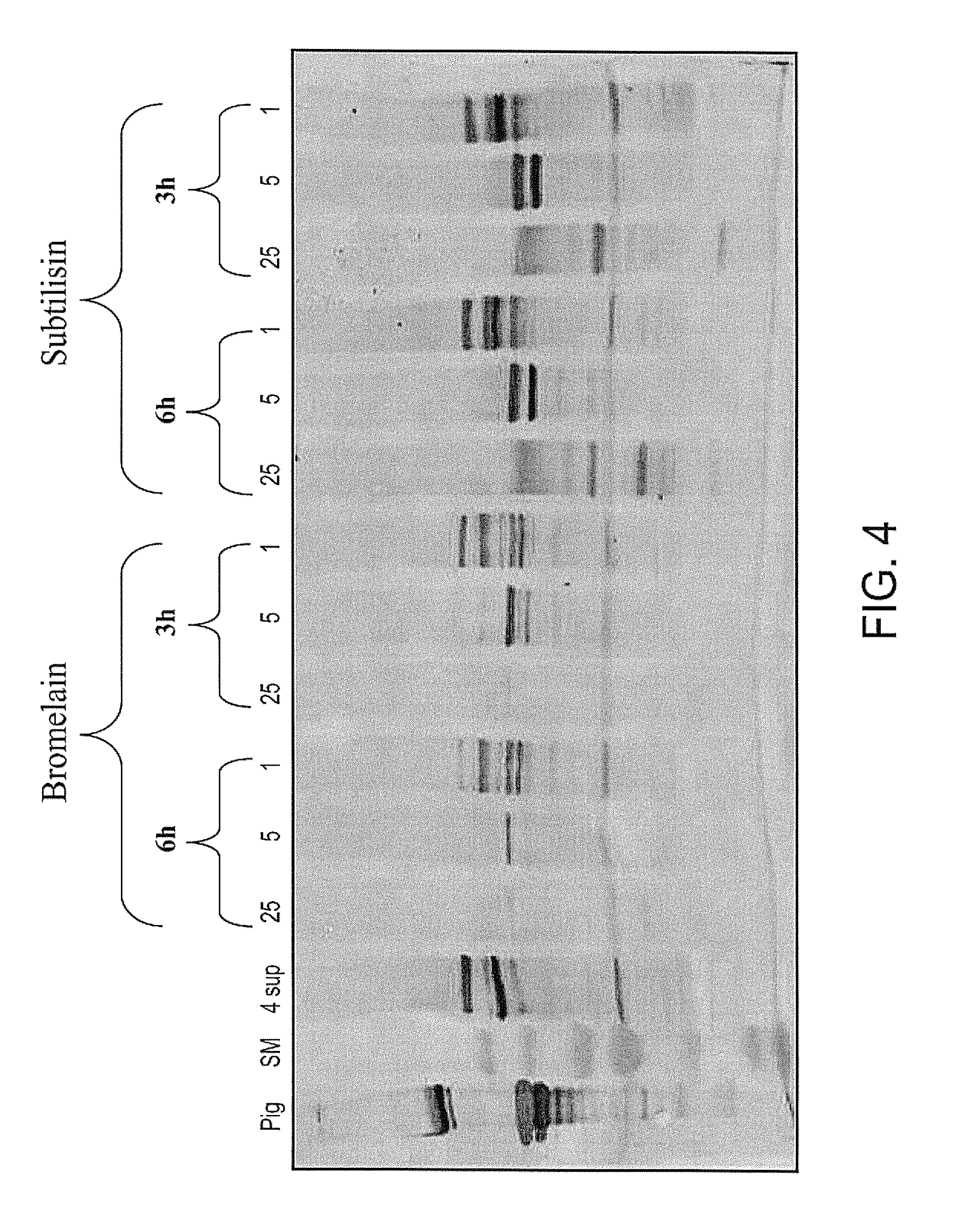Methods of processing recombinant procollagen
a technology of recombinant procollagen and processing method, which is applied in the direction of prothesis, peptide/protein ingredient, peptide, etc., can solve the problems of reducing the homogeneity of protein preparation, less containability of prions, and presenting considerable health risks
- Summary
- Abstract
- Description
- Claims
- Application Information
AI Technical Summary
Benefits of technology
Problems solved by technology
Method used
Image
Examples
example 1
Extraction and Purification of Collagen from Transgenic Plants in the Presence of Trypsin and Pepsin
[0145]The production of human collagen in plants was initiated in order to avoid the use of collagen from mammalian sources since the use of mammalian proteins in human cosmetics or medical applications may be risky to human health as the evolutionary proximity is relativity close. The known disease Creutzfeldt-Jakob disease (CJD) is an example of one which is caused by consumption of infected mammal proteins by humans.
[0146]Initially, the purification of collagen from transgenic plants was performed using bovine pancreatic Trypsin and the digestive protease Pepsin, both of which catalyze the hydrolysis of proteins in the animal digestive system. The following examples illustrate the identification of a protease from a non-animal source suitable for use in the collagen purification process.
[0147]Results
[0148]Propeptide digestion during the purification of collagen was first performed ...
example 2
Collagen Extraction and its Enzymatically-Induced Digestion
[0150]However, the trypsin-pepsin solution was not optimal since it required two different enzymes, lengthening the purification process. Furthermore, both enzymes are from animal sources. In order to overcome these issues, a screen of different protease enzymes of non-animal origin, was performed. Varying digestion patterns were obtained by the different enzymes screened. Very little or no observable digestion of the propeptides resulted from the incubation of collagen with the Savinase (FIG. 6) and Esperase (FIG. 8) enzymes. Incubation with Papain (FIG. 5), Bromelain (FIG. 4), Alcalase 2.4 L and Esperase 8.0 L (FIG. 9), led to over- or under-digestion of the propeptides. Alcalase and Protamex enzymes (FIG. 7) led to the desired digestion pattern and level (25 mg / L, 6 hr), with alpha 1 and alpha 2 chains migrating similar to the pig-derived collagen sample. However, not all the molecules were fully digested and may require ...
example 3
Extraction and Purification of Collagen from Transgenic Plants Following Digestion with Subtilisin or Ficin
[0151]Collagen purifications from 450 gr leaves of transgenic plants (13-361 or 13-6-52) were performed followed by procollagen digestion with Ficin (FIG. 10) or Subtilisin (FIG. 11). Samples of the collagen at the various stages of the purification process were analyzed by Western analysis. Propeptide digestion by ficin and subtilisin led to the desirable degree of processing of Collagen 1 and Collagen 2. Bands of lower molecular weight were observed on the Western blots throughout the purification process, however, these bands appeared in the plant extracts prior to the incubation with the enzyme (lanes 3-4) and also in the pig-derived collagen control sample (positive control) (FIG. 10).
PUM
| Property | Measurement | Unit |
|---|---|---|
| concentrations | aaaaa | aaaaa |
| concentrations | aaaaa | aaaaa |
| pH | aaaaa | aaaaa |
Abstract
Description
Claims
Application Information
 Login to View More
Login to View More - R&D
- Intellectual Property
- Life Sciences
- Materials
- Tech Scout
- Unparalleled Data Quality
- Higher Quality Content
- 60% Fewer Hallucinations
Browse by: Latest US Patents, China's latest patents, Technical Efficacy Thesaurus, Application Domain, Technology Topic, Popular Technical Reports.
© 2025 PatSnap. All rights reserved.Legal|Privacy policy|Modern Slavery Act Transparency Statement|Sitemap|About US| Contact US: help@patsnap.com



